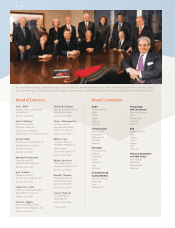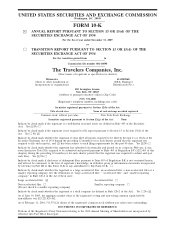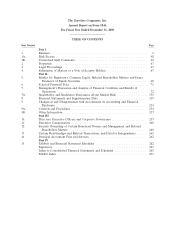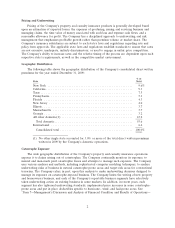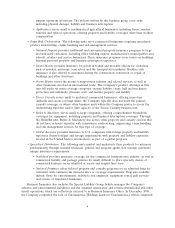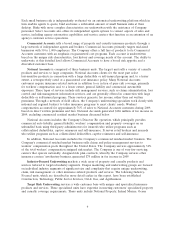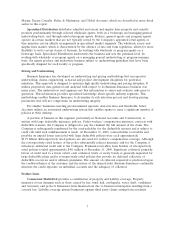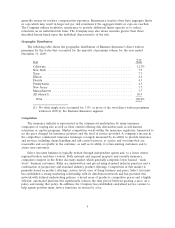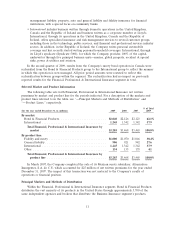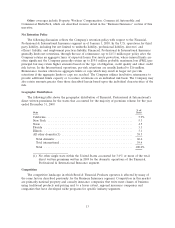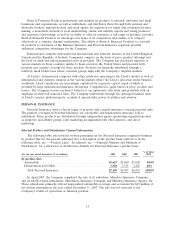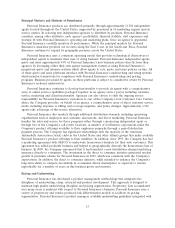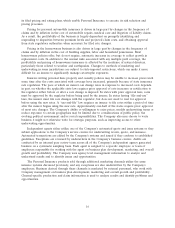Travelers 2009 Annual Report Download - page 20
Download and view the complete annual report
Please find page 20 of the 2009 Travelers annual report below. You can navigate through the pages in the report by either clicking on the pages listed below, or by using the keyword search tool below to find specific information within the annual report.occurring on their premises or arising out of their operations, such as injuries sustained from products
sold.
Workers’ Compensation provides coverage for employers for specified benefits payable under state
or federal law for workplace injuries to employees. There are typically four types of benefits payable
under workers’ compensation policies: medical benefits, disability benefits, death benefits and
vocational rehabilitation benefits. The Company emphasizes managed care cost containment strategies,
which involve employers, employees and care providers in a cooperative effort that focuses on the
injured employee’s early return to work and cost-effective quality care. The Company offers the
following types of workers’ compensation products:
• guaranteed cost insurance products, in which policy premium charges are fixed for the period of
coverage and do not vary as a result of the insured’s loss experience;
• loss-sensitive insurance products, including large deductible and retrospectively rated policies, in
which fees or premiums are adjusted based on actual loss experience of the insured during the
policy period;
• service programs, which are generally sold to the Company’s National Accounts customers,
where the Company receives fees rather than premiums for providing loss prevention, risk
management, and claim and benefit administration services to organizations under service
agreements.
The Company also participates in state assigned risk pools as a servicing carrier and pool
participant.
Commercial Automobile provides coverage for businesses against losses incurred from personal
bodily injury, bodily injury to third parties, property damage to an insured’s vehicle and property
damage to other vehicles and other property resulting from the ownership, maintenance or use of
automobiles and trucks in a business.
Property provides coverage for loss of or damage to buildings, inventory and equipment from
natural disasters, including hurricanes, windstorms, earthquakes, hail, and severe winter weather. Also
covered are man-made events such as theft, vandalism, fires, explosions, terrorism and financial loss
due to business interruption resulting from covered property damage. For additional information on
terrorism coverages, see ‘‘Reinsurance—Catastrophe Reinsurance—Terrorism Risk Insurance Acts.’’
Property also includes specialized equipment insurance, which provides coverage for loss or damage
resulting from the mechanical breakdown of boilers and machinery, and ocean and inland marine,
which provides coverage for goods in transit and unique, one-of-a-kind exposures.
General Liability provides coverage for liability exposures including bodily injury and property
damage arising from products sold and general business operations. Specialized liability policies may
also include coverage for directors’ and officers’ liability arising in their official capacities, employment
practices liability insurance, fiduciary liability for trustees and sponsors of pension, health and welfare,
and other employee benefit plans, errors and omissions insurance for employees, agents, professionals
and others arising from acts or failures to act under specified circumstances, as well as umbrella and
excess insurance.
Net Retention Policy
The following discussion reflects the Company’s retention policy with respect to the Business
Insurance segment as of January 1, 2010. For third party liability, Business Insurance generally limits its
net retention, through the use of reinsurance, to a maximum of $18.8 million per insured, per
occurrence after the Company retains an aggregate layer of expected losses. The net retained amount
per risk for property exposures is generally limited to $15.0 million, after reinsurance. The Company
8


